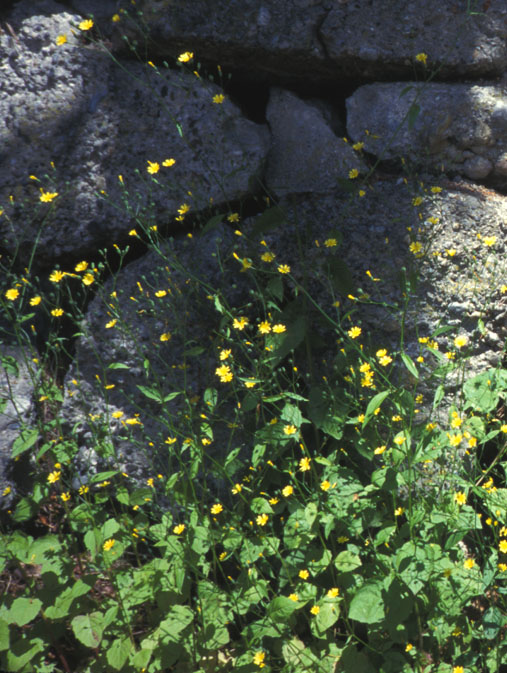
|
| Nipplewort; Lapsana communis L. |
Sunflower Family; COMPOSITÆ (ASTERACEÆ)
|
| Nipplewort is practically unknown by name to most of us, but is a familiar sight, being a most common weed. In fact, almost no
weed so common and conspicuous is so little known by name. When first trying to learn plant names, it exasperated me. You, however, do
not need to repeat my fumbling: allow me to introduce you to this bland herb. |
| Like most of Seattle's weeds, it is a fugitive from Europe. For 350 years it has been going under the book name Nipplewort,
coined by John Parkinson: |
| "Camerarius [a Nuremberg physician and botanist] saith that in Prussia they call it
Papillaris, because it is good to heale the
ulcers of the nipples of womens breasts, and thereupon I have intituled it Nipplewort in English."
Theatrum Botanicum; or an Herball of Large
Extent, 1640, page 811. |
| French and German equivalents of Parkinson's English name are Herbe aux Mamelles, and Niplewurz. Other, real-life rather than
book-coined European names generally allude to the plant's edible leaves. Some English names of limited use and weird meaning
include: Carpenter's Apron, Mary Alone, Hasty Sergeant, and Dockorenes. Does anyone knows what these names signify? If so, kindly share
your secret wisdom with the rest of us. |
| The plant has a one-year or annual lifespan. Its seeds can sprout anytime, but most of them do so during wet months. Seedlings
are softly covered with whitish hairs and grow in shade or sunshine. The leaves are light green, thin and weak. The illustration shows
their peculiar shapes. Flowerstems ascend in late spring. They ultimately top out anywhere from 2 to 6 feet in height, are hollow, leafy, and
much branched. The flowerbuds, that supposedly resemble nipples enough to have suggested a medicinal use, open miniature
dandelion blossoms, about the size of a dime. During foul weather the flowers stay shut. Late May through August it is easy to find specimens in
bloom. Some flowers can linger into November. |
| After pollination is done, the petals fall away and the seeds are set to ripen; some individual Nipplewort weeds can produce 1,000
seeds! Unlike dandelion seeds, these are not equipped with airy plumes to float them upon the wind. Instead they rattle in their drying cases,
and get tossed hither and yonder by whatever force agitates the drying weed. During winter, the distinctive brown, brittle remains stand
evident, the seeds gone. |
| Nipplewort is good eating despite its mild bitterness and decidedly hairy, therefore chewy, foliage. You can eat the leaves or
upper stem portions raw, as is, or can prepare them however you prefer your greens. I am unaware of any nutritional studies carried out on
this weed, but if it is at all similar in value to its relatives, we will benefit from ingesting it. Medicinally it is impotent: no better than
lettuce. You will notice upon plucking a bit of the plant, that it causes a thick white juice to appear, much like numerous related weeds in
the sunflower family. Many yellow-flowered dandelion cousins exist in the Seattle area. A rare white flowered Nipplewort also exists. |
Unless the soil is quite heavy or dry, yanking up unwanted Nippleworts is easy. The weed doesn't grow in lawns or meadows. It
is frequent in woodsy areas, gardens and disturbed sites. People keen on wild edible plants should definitely become intimate with it.
Being so common, cold-hardy and mildly flavored, this hairy herb is staple of weed salads. The rest of us should at least know its name.
|
Originally published as the Seattle Tilth newsletter Weed of the Month in November 1991, along with an illustration drawn by Alice Dubiel.
Back |
|
|

